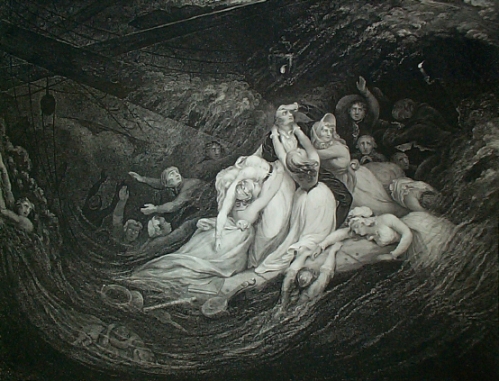Sea – Ship – drowned – Shipwreck – so it came,
The meek, the brave, the good, was gone:
He who had been our living John
Was nothing but a name. – William Wordsworth

The Shipwreck, 1805, Turner
In 1805, John Wordsworth, a captain employed by the East India Company and younger brother of the poet William Wordsworth, died along with 2/3 of his crew on board the Earl of Abergavenny only 1 1/2 miles off the shoreline of Weymouth in shallow waters. John was anxious to sail from Portsmouth, for he had invested a large sum of his own money in this trip, intending to make a fortune for himself and his family, including his brother William.

Loss of the Abergavenny
The ship, headed for India and China, carried valuable goods such as books, lace, perfume and silver for trade, and was worth an estimated £270,000. (John’s investment represented only a tiny portion of the whole.) The Earl of Abergavenny encountered bad weather and hit an underwater shingle bank off Portland, and was “badly holed.” Taking in water, the ship was unable to reach a safe haven. Most of those who died, did so from drowning or the cold. It was surmised that John Wordsworth did not try to save himself, but clung to the ropes and drowned with his ship.

Rowing to the Rescue, Shipwrecked Sailors Off the Northumberland Coast
Rescuing those in distress was a perilous venture, for storm conditions made it extremely dangerous for rescuers to set out. While sea rescues were dangerous, there was a cost benefit for the local citizens, for many of the ships carried precious cargo. Once the crew had been saved, the locals could plunder the bounty after the storm had subsided, which many did. A breed of dog known as the Portland Newfoundland Sea Dog or Rescue Dog (which died out in the 19th century), was trained to rescue people in danger of drowning.

Portland Sea Dog: "portrait of a dog which brought 3 barrels of spirits out of the sea."
Jane Austen would most likely have heard of the loss of The Abergavenny, as well as the story of another famous tragedy, that of the Halsewell, which foundered in Weymouth Bay in 1786. This wreck was especially poignant, for the captain died along with his two daughters.

Loss of the Halsewell, Wilkinson
Over a hundred perished in the wreck, including the Captain, his two daughters and nieces, and the First Officer, his nephew. Another 60 seamen and soldiers, who managed to reach the cliffs, died of cold or were washed into the sea. About 70 were rescued from the cliffs. – The British Library
The tragedy, with the deaths of so many, including the women (who had joined the voyage probably in search of marriage), excited the keen interest of the public. Two ship’ officers wrote an account, which sits in the British Library. Read portions of the account in this link.
The waters off East Sussex were known for their treacherous conditions, and over 1,000 ships have wrecked in the area. Strong undertows and currents, shingle banks, and unexpected storms combine to make the area deadly.
As John Meade Faulkner wrote in his classic tale “Moonfleet” in 1898, “And once on the beach, the sea has little mercy, for the water is deep right in, and the waves curl over full on the pebbles with a weight no timbers can withstand. Then if the poor fellows try to save themselves, there is a deadly undertow or rush-back of the water, which sucks them off their legs, and carries them again under the thundering waves. It is that back-suck of the pebbles that you may hear for miles inland, even at Dorchester, on still nights long after the winds that caused it have sunk, and which makes people turn in their beds, and thank God they are not fighting with the sea on Moonfleet Beach”
Hurricane and storm surges make the area dangerous for the citizenry as well. In 1824, a storm surge swept over the shingle spit on which a Georgian housing development (pictured above) sat, and swept away parts of villages. There was extensive damage as is indicated in the image below.*

Hurricane Map, 1824

Luworth Cove, Dorset
More Information on the Topic
JMW Turner: The Shipwreck, 1805
East Devon and Dorset World Heritage Site
Grace Galleries: Images of Shipwrecks









Very interesting and original post. Very good pictures, too.
[…] This post was Twitted by janeaustenworld […]
Ah, yes, Dorset’s shipwrecks! The two biggest dangers are the Shambles Sandbank (which was what claimed the Abergavenny) and the Portland Race, where the currents and tides clash.
I visit this country yearly and I’ve been caught in storms (it’s as though the wind gets trapped in Lyme Bay). Even now it’s still a highly dangerous place for ships, tho I don’t think there’s been a wrecking on the scale (death wise, anyway) of either the Abergavenny or Halsewell for decades or more.
The last big ship to be beached was the Napoli down on the Devon side of Lyme Bay. The locals still practise their salvaging rights, even in 2007!
http://www.weymouthdiving.co.uk/abergavenny.htm
You might find this website interesting – it’s details of the Abergavenny and the archaeology they’ve been carrying out on her :)
Fascinating article, as always. I have a copy of William Wordworth’s elegy to his brother in a book somewhere (he and many of other shipwreck victims are buried in Wyke Regis), which I could dig up and post in another comment later, if you’d like.
Makes me want to go on holiday now and dig around for Austen in Dorset! Which I confess I’ve never really done before, but I’ll make it my aim next time I go.
First, thank you for stopping by, Jacobea, and adding to this post. I had no idea that the seas were so dangerous in this area, or else I would have paid closer attention to the waters when we traveled in the region. If you click on William Wordsworth name in the quote, it will lead to the entire elegy. I should have been clearer on that. The embedded links are not quite so evident as I would like.
Thank you for your interest and comments! A part of the novel Persuasion is set in Lyme Regis, one of Jane Austen’s favorite seaside resorts. I imagine you have been there …?
I think the danger tends to vary depending on tides and wind strength – several of the accounts in the book I have describe boats literally being “blown onto the rocks”, and both the Abergavenny and Halsewell wrecked because of storms in the Channel – high winds and heavy ships, never the greatest combination.
And I saw that link after I posted the comment – my bad!
I have been to Lyme Regis several times over the past ten or so years, but I have to say that, recently, I personally find that it’s lost its old fashioned charm :( Since the World Heritage status was granted, it’s gotten very tourist-y (too much for my liking). However, up round the back and in the parts near the church and fossil bearing cliffs (where few seem to go, oddly enough), much of Lyme does remain rather old looking and downright untouched even. If Jane Austen were travel forward in time, she would probably recognise that much of the town anyway :)
[…] Perils of the Sea: Shipwrecks off Dorset’s Deadly Coast « Jane … […]
An account of the demise of the Halsewell can be seen in the Seadart web site.
http://www.seadart.net
Also an account of the latest diving operations taking place on the Halsewell wreck site.
[…] Perils of the Sea: Shipwrecks off Dorset’s Deadly Coast […]
[…] Perils of the Sea: Shipwrecks off Dorset’s Deadly Coast […]